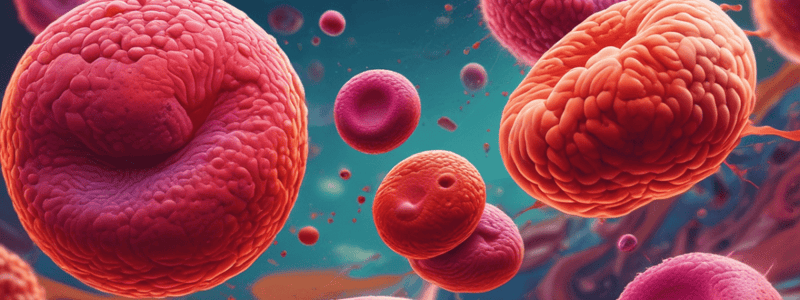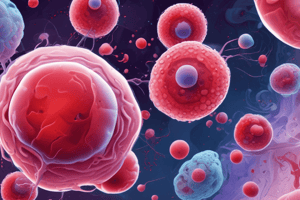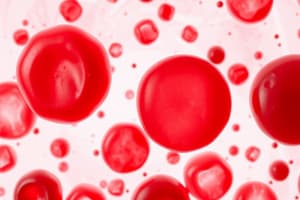Podcast
Questions and Answers
What is the primary cause of hemolytic disease of the newborn (erythroblastosis fetalis) described in the passage?
What is the primary cause of hemolytic disease of the newborn (erythroblastosis fetalis) described in the passage?
- Immaturity of the bilirubin-conjugating system
- Increased production of unconjugated bilirubin
- Rh-positive blood transfusion in Rh-negative individuals
- Rh-negative mothers carrying Rh-positive fetuses (correct)
What is the most serious complication of severe hemolysis in the fetus described in the passage?
What is the most serious complication of severe hemolysis in the fetus described in the passage?
- Anemia
- Infant death in utero (correct)
- Severe jaundice
- Edema (hydrops fetalis)
What is the neurological syndrome that can develop in infants with erythroblastosis fetalis, especially if complicated by hypoxia?
What is the neurological syndrome that can develop in infants with erythroblastosis fetalis, especially if complicated by hypoxia?
- Neonatal brain injury
- Hyperbilirubinemia
- Kernicterus (correct)
- Bilirubin encephalopathy
Why is the concentration of unconjugated bilirubin very high in infants with erythroblastosis fetalis?
Why is the concentration of unconjugated bilirubin very high in infants with erythroblastosis fetalis?
How does sensitization of Rh-negative mothers by carrying an Rh-positive fetus typically occur?
How does sensitization of Rh-negative mothers by carrying an Rh-positive fetus typically occur?
What percentage of Rh-positive fetuses born to Rh-negative mothers who have been pregnant one or more times with Rh-positive fetuses develop hemolytic disease?
What percentage of Rh-positive fetuses born to Rh-negative mothers who have been pregnant one or more times with Rh-positive fetuses develop hemolytic disease?
Which of the following cell types arise from a common precursor?
Which of the following cell types arise from a common precursor?
What is the approximate normal range of total white blood cells per microliter in human blood?
What is the approximate normal range of total white blood cells per microliter in human blood?
Which of the following cell types are derived from bone marrow stem cells?
Which of the following cell types are derived from bone marrow stem cells?
What is the percentage range for neutrophils among the total white blood cells?
What is the percentage range for neutrophils among the total white blood cells?
Which of the following statements about hematopoietic stem cells (HSCs) is true?
Which of the following statements about hematopoietic stem cells (HSCs) is true?
What is the approximate normal range for erythrocytes (red blood cells) per microliter in human blood?
What is the approximate normal range for erythrocytes (red blood cells) per microliter in human blood?
What is the primary function of the capillary beds in the cardiovascular system?
What is the primary function of the capillary beds in the cardiovascular system?
What is the primary mechanism by which fluid leaves the circulation across the walls of capillaries?
What is the primary mechanism by which fluid leaves the circulation across the walls of capillaries?
Which of the following is NOT a factor that governs the flow of blood through each segment of the circulation?
Which of the following is NOT a factor that governs the flow of blood through each segment of the circulation?
What is the most common cause of hypertension in humans?
What is the most common cause of hypertension in humans?
What is the main consequence of untreated hypertension?
What is the main consequence of untreated hypertension?
Which of the following is NOT a characteristic of the contractile properties and regulatory mechanisms of the vasculature?
Which of the following is NOT a characteristic of the contractile properties and regulatory mechanisms of the vasculature?
What is the primary reason for the popularity of banking one's own blood before elective surgery?
What is the primary reason for the popularity of banking one's own blood before elective surgery?
What is the advantage of autologous transfusion mentioned in the text?
What is the advantage of autologous transfusion mentioned in the text?
Which of the following statements about the Rh group is true?
Which of the following statements about the Rh group is true?
What is the purpose of checking the action of the donor's plasma on the recipient cells before a transfusion?
What is the purpose of checking the action of the donor's plasma on the recipient cells before a transfusion?
What is the purpose of withdrawing the patient's own blood before elective surgery?
What is the purpose of withdrawing the patient's own blood before elective surgery?
What is the function of the D protein in the Rh group?
What is the function of the D protein in the Rh group?
What is the primary function of hemoglobin in red blood cells?
What is the primary function of hemoglobin in red blood cells?
Which of the following statements about fetal hemoglobin is true?
Which of the following statements about fetal hemoglobin is true?
What is the basis of the ABO blood group system?
What is the basis of the ABO blood group system?
What can happen when an individual receives an inappropriate blood transfusion?
What can happen when an individual receives an inappropriate blood transfusion?
What is the sequence of blood flow in the cardiovascular system?
What is the sequence of blood flow in the cardiovascular system?
Which of the following statements about blood cells is true?
Which of the following statements about blood cells is true?
What is the primary function of the granules found in eosinophils?
What is the primary function of the granules found in eosinophils?
What is the primary role of lymphocytes in the body's immune defenses?
What is the primary role of lymphocytes in the body's immune defenses?
What is the primary mechanism by which platelets are produced in the body?
What is the primary mechanism by which platelets are produced in the body?
What is the primary function of hemoglobin in red blood cells?
What is the primary function of hemoglobin in red blood cells?
What is the primary mechanism by which fluid leaves the circulation and enters the tissues across the walls of capillaries?
What is the primary mechanism by which fluid leaves the circulation and enters the tissues across the walls of capillaries?
What is the primary purpose of checking the action of the donor's plasma on the recipient cells before a blood transfusion?
What is the primary purpose of checking the action of the donor's plasma on the recipient cells before a blood transfusion?
What is the term for bone marrow that is infiltrated with fat and no longer actively producing blood cells?
What is the term for bone marrow that is infiltrated with fat and no longer actively producing blood cells?
Which cell type forms the majority (75%) of the cells in the bone marrow, responsible for producing white blood cells?
Which cell type forms the majority (75%) of the cells in the bone marrow, responsible for producing white blood cells?
What is the term for bone marrow cells capable of producing all types of blood cells?
What is the term for bone marrow cells capable of producing all types of blood cells?
What reflects the difference between white blood cell and red blood cell production in the bone marrow?
What reflects the difference between white blood cell and red blood cell production in the bone marrow?
What happens in diseases where bone marrow becomes destroyed or fibrosed in adults?
What happens in diseases where bone marrow becomes destroyed or fibrosed in adults?
What is the term for active cellular marrow in the bone?
What is the term for active cellular marrow in the bone?
What is the specific gravity of blood?
What is the specific gravity of blood?
Why does blood appear scarlet red when taken from arteries and purplish from veins?
Why does blood appear scarlet red when taken from arteries and purplish from veins?
What is the primary mechanism that leads to the formation of a definitive clot after a blood vessel is damaged?
What is the primary mechanism that leads to the formation of a definitive clot after a blood vessel is damaged?
How does blood act as a transport medium in the body?
How does blood act as a transport medium in the body?
What is the approximate percentage of plasma in the total circulating blood volume?
What is the approximate percentage of plasma in the total circulating blood volume?
What is the primary cause of the vasoconstriction that occurs in an injured arteriole or small artery?
What is the primary cause of the vasoconstriction that occurs in an injured arteriole or small artery?
What is the fundamental reaction involved in the clotting mechanism described in the passage?
What is the fundamental reaction involved in the clotting mechanism described in the passage?
Where are red blood cells, white blood cells, and platelets formed in adults?
Where are red blood cells, white blood cells, and platelets formed in adults?
What is the primary function of the temporary hemostatic plug formed by platelets after a blood vessel is damaged?
What is the primary function of the temporary hemostatic plug formed by platelets after a blood vessel is damaged?
What is the role of blood cells in maintaining the cellular environment?
What is the role of blood cells in maintaining the cellular environment?
What is the primary purpose of the series of enzymatic reactions and clotting factors involved in the clotting mechanism described in the passage?
What is the primary purpose of the series of enzymatic reactions and clotting factors involved in the clotting mechanism described in the passage?
What is the primary role of fibrin in the clotting mechanism described in the passage?
What is the primary role of fibrin in the clotting mechanism described in the passage?
What is the primary cause of dangerous hemolytic transfusion reactions during blood transfusions?
What is the primary cause of dangerous hemolytic transfusion reactions during blood transfusions?
Why does the dilution of plasma in the recipient usually prevent agglutination during blood transfusions?
Why does the dilution of plasma in the recipient usually prevent agglutination during blood transfusions?
Which blood type is most likely to have a high frequency of plasma containing anti-B agglutinins?
Which blood type is most likely to have a high frequency of plasma containing anti-B agglutinins?
What happens when an individual with type A blood has their plasma mixed with type B red cells?
What happens when an individual with type A blood has their plasma mixed with type B red cells?
Why is hemolysis more likely to occur when recipient's plasma has agglutinins against the donor's red cells?
Why is hemolysis more likely to occur when recipient's plasma has agglutinins against the donor's red cells?
What is the primary method used for ABO blood typing?
What is the primary method used for ABO blood typing?
Flashcards are hidden until you start studying
Study Notes
Hemolytic Disease of the Newborn
- When anti-Rh agglutinins cross the placenta to an Rh-positive fetus, they can cause hemolysis and various forms of hemolytic disease of the newborn (erythroblastosis fetalis).
- Hemolysis in the fetus can cause anemia, severe jaundice, and edema (hydrops fetalis).
- Kernicterus, a neurologic syndrome, may also develop, especially if birth is complicated by a period of hypoxia.
Blood Cells and Bone Marrow
- There are separate pools of progenitor cells for megakaryocytes, lymphocytes, erythrocytes, eosinophils, and basophils; neutrophils and monocytes arise from a common precursor.
- The bone marrow stem cells are also the source of osteoclasts, Kupffer cells, mast cells, dendritic cells, and Langerhans cells.
- HSCs are few in number but are capable of completely replacing the bone marrow when injected into a patient whose own bone marrow has been entirely destroyed.
White Blood Cells
- Normally, human blood contains 4,000-11,000 white blood cells per microliter.
- Neutrophils are the most numerous, making up 50-70% of total white blood cells.
- Lymphocytes make up 20-40%, monocytes make up 2-8%, and eosinophils and basophils make up 1-4%.
Erythrocytes
- Erythrocytes (red blood cells) contain hemoglobin, which transports oxygen to peripheral tissues.
- Fetal hemoglobin is specialized to facilitate diffusion of oxygen from mother to fetus during development.
- Mutated forms of hemoglobin lead to red cell abnormalities and anemia.
Blood Groups and Transfusion Reactions
- The ABO blood group system is based on complex oligosaccharide structures specific to groups of individuals.
- Incompatible blood transfusions can trigger the production of antibodies, leading to erythrocyte agglutination and potentially serious consequences.
- Transfusion reactions occur when blood is transfused into an individual with an incompatible blood type, resulting in hemolysis and the liberation of free hemoglobin into the plasma.
Cardiovascular System and Blood Flow
- Blood flows from the heart to arteries and arterioles, then to capillaries, and eventually to venules and veins and back to the heart.
- The cardiovascular system has specific contractile properties and regulatory mechanisms that subserve physiologic function.
- Transfer of oxygen and nutrients from the blood to tissues, as well as collection of metabolic wastes, occurs exclusively in the capillary beds.
Platelets and Blood Clotting
- Platelets are small, granulated bodies that aggregate at sites of vascular injury.
- Megakaryocytes in the bone marrow form platelets by pinching off bits of cytoplasm and extruding them into the circulation.
- The clotting mechanism involves a cascade of enzymatic reactions and a series of numbered clotting factors, resulting in the conversion of fibrinogen to fibrin.
Studying That Suits You
Use AI to generate personalized quizzes and flashcards to suit your learning preferences.




